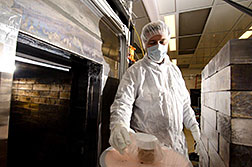- Number 408 |
- March 3, 2014
PNNL offers ‘virtual tour’ of Shallow Underground Laboratory

Scientists use ultra-sensitive germanium
detectors to perform low-background
measurements on a variety of samples,
addressing applications that span from
environmental age-dating to international
treaty verification.
For the first time, some of the world’s most sensitive radiation detection systems and fundamental physics research can be seen from either your desktop computer or mobile device. DOE’s Pacific Northwest National Laboratory recently launched a virtual tour showcasing its Shallow Underground Laboratory (SUL), a facility dedicated in 2011 as part of the $224-million capability replacement project jointly funded by DOE, National Nuclear Security Administration, and Department of Homeland Security. The SUL is a one-of-a-kind facility most people may never be able to visit in order to protect sensitive instruments from outside contamination and even the slightest radioactivity.
Scientists in the SUL conduct research which includes the construction of a variety of sensitive detectors that require ultra low background environments. These can be used for international treaty verification for the Comprehensive-Nuclear-Test Ban Treaty to basic science research such as the search for dark matter in the universe or neutrinoless double-beta decay. The virtual tour allows visitors to witness the development of gas proportional counters or germanium detectors with extraordinary detection efficiencies that are constructed of ultra-pure copper in the SUL laboratories.
To take the SUL virtual tour, go to http://tour.pnnl.gov/ and click on the facility marked Shallow Underground Laboratory. Once in the virtual environment, you’ll hear a short introduction and then can self-navigate through the drop-down menu, the map, or the arrow to enter through the front door. At any point you can jump to the virtual tour by clicking “View Tour.” At each tour stop, you have the ability to zoom and pan 360 degrees within the laboratories. Short video features, interviews, reference information and more are scattered throughout the tour.[Kristin Manke, 509.372.6011,
kristin.manke@pnnl.gov]
